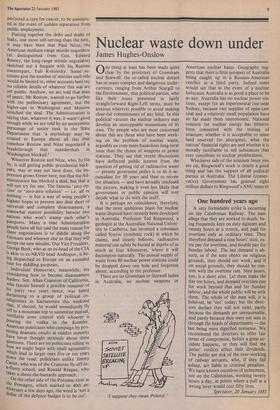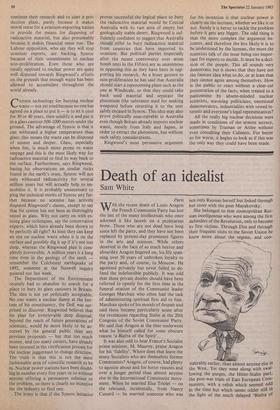Nuclear waste down under
James Hughes-Onslow
nne thing at least has been made quite V clear by the protesters of Greenham and Sizewell: the so-called nuclear debate has so many complex and dangerous under- currents, ranging from Arthur Scargill to the Environment, that political parties, who like their issues presented in fairly straightforward Right-Left terms, must be anxious wherever possible to avoid making clear-cut commitments of any kind. In this political vacuum the nuclear industry may develop an unstoppable momentum of its own. The people who are most concerned about this are those who have been work- ing on the problem of nuclear waste, arguably an even more hazardous long-term issue than the choice of weapons or power stations. They say that recent discussions have deflected public interest from the question of getting rid of radioactive waste — present goverment policy is to let it ac- cumulate for 50 years and then to reivew the situation — and have actually confused the picture, making it even less likely that government or public opinion will ever decide what to do with the stuff.
It is perhaps no coincidence, therefore, that the most ambitious plans for nuclear waste disposal have recently been developed in Australia. Professor Ted Ringwood, a geologist at the Australian National Univer- sity in Canberra, has invented a substance called Synroc (synthetic rock) in which he claims, and clearly believes, radioactive material can safely be buried at depths of as Much as four kilometres, where it will decompose naturally. The annual supply of waste from 80 nuclear power stations could be dropped down one hole and forgotten about, according to the professor.
There are no Greenham or Sizewell ladies in Australia, no nuclear weapons or '1 suppose They mean Poland.' American nuclear bases. Geography sug- gests that there is little prospect of Australia being caught up in a Russian-American conflict as a third party. Indeed some would say that in the event of a nuclear holocaust Australia is as good a place to be as any. Australia has no nuclear power sta- tions, except for an experimental one near Sydney, because vast supplies of open-cast coal and a relatively small population have so far made them uneconomic. National concern for nuclear energy has hitherto been connected with the mining of uranium: whether it is acceptable to mine land reserved for aborigines, what the natives' financial rights are and whether it is morally justifiable to sell substances that may contribute to nuclear proliferation.
Whichever side of the uranium fence you are on, Ringwood's work is clearly a good thing and has the support of all political parties in Australia. The Liberal (conser- vative) Government has granted eight million dollars to Ringwood's ANU team to
continue their research and to start a pro- duction plant, partly because it makes moral sense for a uranium-exporting nation to provide the means for disposing of radioactive material, but also presumably because it makes financial sense too. The Labour opposition, who say they will stop uranium exports, are backing Synroc because of their commitment to nuclear non-proliferation. Even those who are totally opposed to nuclear power are quite well disposed towards Ringwood's efforts on the grounds that enough waste has been allowed to accumulate throughout the world already.
current technology for burying nuclear V./waste— not yet tried because no one has agreed on a place to put it — is to let it cool for 30 or 40 years, then solidify it and put it in a glass canister 500-1000 metres under the ground. The advantage of Synroc is that it can withstand a higher temperature than glass: this means the waste can be disposed of sooner and deeper. Glass, especially when hot, is much more prone to water seepage and this is the most likely way for radioactive material to find its way back to the surface. Furthermore, says Ringwood, basing his observations on similar rocks found in the earth's crust, Synroc will not only withstand radioactivity for several million years but will actually help to im- mobilise it. It is probably unnecessary to plug the technical merits of Synroc any fur- ther because no scientist has actively disputed Ringwood's claims, except to say that his system has not been as thoroughly tested as glass. Why not carry on with ex- isting glass techniques, say the conservative experts, which have already been shown to be perfectly all right? At least they can keep an eye on nuclear waste when it is on the surface and possibly dig it up if it's not too deep, whereas the Ringwood plan is com- pletely irreversible. A million years is a long time even in the geology of the earth remember the Colchester earthquake of 1892, someone at the Sizewell inquiry pointed out last week.
The Department of the Environment recently had to abandon its search for a place to bury its glass canisters in Britain. The idea is not yet politically acceptable. No one wants a nuclear dump at the bot- tom of his constituency, the DoE was sur- prised to discover. Ringwood believes that his plan for irretrievable deep disposal, beyond the reach of future generations of scientists, would be more likely to be ac- cepted by the general public than any previous proposals — but that too much money, and too many careers, have already been invested in the vitrification process for the nuclear juggernaut to change direction. The truth is that this is not the most fashionable area of scientific research to be in. Nuclear power stations have been doubl- ing in number every five years or so without anyone offering a permanent solution to the problem, so there is clearly no incentive for the industry to find one.
The irony is that if the Synroc initiative proves successful the logical place to bury the radioactive material would be Central Australia with its vast area of empty but geologically stable desert. Ringwood is suf- ficiently confident to suggest that Australia should offer to bury radioactive material from countries that have imported its uranium. But political parties (especially after the recent controversy over atom bomb tests in the Fifties) are as unanimous in opposing this as they have been in sup- porting his research. As a lesser gesture to non-proliferation he has said that Australia should start a reprocessing plant such as the one at Windscale, so that they could take back used material and separate the plutonium (the substance used for making weapons) before returning it to the user safely encased in Synroc. This idea may also prove politically unacceptable in Australia even though Britain already imports nuclear waste, mostly from Italy and Japan, in order to extract the plutonium, but without such safety considerations.
Ringwood's most persuasive argument for his invention is that nuclear power is clearly on the increase, whether we like it or not. Surely it is better to tackle the problem before it gets any bigger. The odd thing is that the more complex the argument be- comes, and therefore the less likely it is to be understood by the layman, the more the scientists talk of the issue being too impor- tant for experts to decide. It must be a deci- sion of the people. This all sounds very democratic but it shows that they have not the faintest idea what to do, or at least that they cannot agree among themselves. How is the public to react without a clear-cut presentation of the facts, when treated to a pantomime by absent-minded nuclear scientists, wavering politicians, emotional demonstrators, industrialists with vested in- terests and everyone's legal representatives?
All the really big nuclear decisions were made in conditions of the utmost secrecy, sometimes by Truman or Attlee without even consulting their Cabinets. For better or for worse, it begins to look as if this was the only way they could have been made.







































 Previous page
Previous page